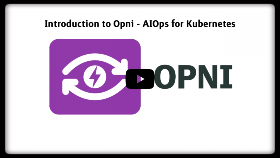opni
 opni copied to clipboard
opni copied to clipboard
Multi Cluster Observability with AIOps
Opni = AIOps for Kubernetes + Observability Tools
Opni currently features log anomaly detection for Kubernetes.
What does Opni give me?
- AI generated insights on your cluster's log messages
-
Control Plane & etcd insights
- Pretrained models maintained by Rancher Labs
-
Control Plane & etcd insights
- Every log message sent to Opni will be marked as:
- Normal
- Suspicious - Operators may want to investigate
- Anomalous - Operators definitely should investigate
- Opensearch + Opensearch Dashboards
- Opni dashboard to consume log insights & explore logs

Deprecation Notice
- GPU Learning is temporarily disabled in the v0.4.0 release as Opni moves to a multicluster architecture. This will be returning in a future release
- The v1beta1 API has been deprecated in this release. Please migrate to v1beta2.
- The UI and Insights services, which were experimental, have been removed
Getting started with Opni
Full Install Opni in your Kubernetes cluster:
Manifests install (recommended):
Prerequisites:
- Cert manager installed. This can be installed with the following command:
kubectl apply -f https://github.com/cert-manager/cert-manager/releases/download/v1.7.2/cert-manager.yaml - Opni Gateway installed - see the Main Cluster docs for Opni Monitoring
Installation:
- All clusters (both the main cluster and clusters to collect logs from) the manifests in deploy/manifests in order from 00 - 10.
- Deploy an Opensearch cluster e.g (node this cluster will need to be exposed via a LoadBalancer or Ingress to allow logs to be indexed)
apiVersion: opensearch.opster.io/v1 kind: OpenSearchCluster metadata: name: opni namespace: opni-cluster-system spec: # Add fields here general: httpPort: 9200 vendor: opensearch version: 1.2.3 serviceName: os-svc setVMMaxMapCount: true confMgmt: autoScaler: false monitoring: false dashboards: enable: true version: 1.2.0 replicas: 1 nodePools: - component: master replicas: 3 diskSize: 32 resources: requests: cpu: 500m memory: 1Gi limits: memory: 1Gi roles: - master persistence: emptyDir: {} - component: nodes replicas: 2 diskSize: 32 resources: requests: cpu: 500m memory: 2Gi limits: memory: 2Gi jvm: "-Xmx1G -Xms1G" roles: - data persistence: emptyDir: {} - Bind Opni to the Opensearch cluster:
apiVersion: opni.io/v1beta2 kind: MulticlusterRoleBinding metadata: name: opni-logging namespace: opni-cluster-system spec: opensearch: name: opni namespace: opni-cluster-system opensearchExternalURL: https://external.opensearch.url - Deploy the Opni pretrained Kubernetes model
apiVersion: opni.io/v1beta2 kind: PretrainedModel metadata: name: control-plane namespace: opni-cluster-system spec: source: http: url: "https://opni-public.s3.us-east-2.amazonaws.com/pretrain-models/control-plane-model-v0.4.0.zip" hyperparameters: modelThreshold: "0.6" minLogTokens: 1 isControlPlane: "true" - Deploy Opni AI services
apiVersion: opni.io/v1beta2 kind: OpniCluster metadata: name: demo namespace: opni-cluster-system spec: version: v0.4.0 deployLogCollector: false services: gpuController: enabled: false inference: pretrainedModels: - name: control-plane opensearch: externalOpensearch: name: opni namespace: opni-cluster-system enableLogIndexManagement: false s3: internal: {} nats: authMethod: nkey - Add additional Logging clusters from the Opni Gateway UI
Consume insights from the Opni Dashboard in Opensearch Dashboards. You will need to expose the Dashboards service or port forward to do this.
Watch a demo of Opni:
What's next?
- v0.1.1 (Released) allows you to view Opni's log anomaly insights only on a demo environment created on a VM
- v0.1.2 (Released) allows you install Opni into your existing Kubernetes cluster and consume log insights from it
- v0.1.3 (August 2021) - only 1 GPU required, changes to the Opni operator, log anomaly optimizations
- v0.2.0 (Fall 2021) will introduce a custom UI, AI applied to metrics, kubernetes events, audit logs, and more!

License
Copyright (c) 2014-2020 Rancher Labs, Inc.
Licensed under the Apache License, Version 2.0 (the "License"); you may not use this file except in compliance with the License. You may obtain a copy of the License at
http://www.apache.org/licenses/LICENSE-2.0
Unless required by applicable law or agreed to in writing, software distributed under the License is distributed on an "AS IS" BASIS, WITHOUT WARRANTIES OR CONDITIONS OF ANY KIND, either express or implied. See the License for the specific language governing permissions and limitations under the License.
Opni Monitoring is an open-source multi-cluster monitoring system. It ingests Prometheus metrics from any number of Kubernetes clusters and provides a centralized observability plane for your infrastructure. Use Opni Monitoring to visualize metrics from all your clusters at once, and give every user their own customized view using granular access control.
⚡ Powered by Open-Source
Opni Monitoring is completely free Apache-licensed open-source software. It builds upon existing, ubiquitous open-source systems - Prometheus, Grafana, and Cortex - and extends them with a number of powerful enterprise features typically only found in SaaS platforms and other proprietery solutions.
🔋 Batteries Included
Opni Monitoring comes out of the box with all the tools you need to get started with multi-cluster monitoring. Manage your clusters and configure access control rules with the built-in dashboard, command-line interface, or REST API.
Opni Monitoring is secure-by-default and uses a zero-trust architecture for inter-cluster communication, with no extra setup required.
🔒 You Own Your Data
With Opni Monitoring, you have complete control over how and where your data is stored. Metric storage is powered by Cortex, which provides comprehensive configuration options for data storage and retention. Several storage backends are available including S3 (cloud or self-hosted), Swift, and Kubernetes Persistent Volumes.
Get started
Check out the Opni Monitoring Documentation for installation guides and more.
